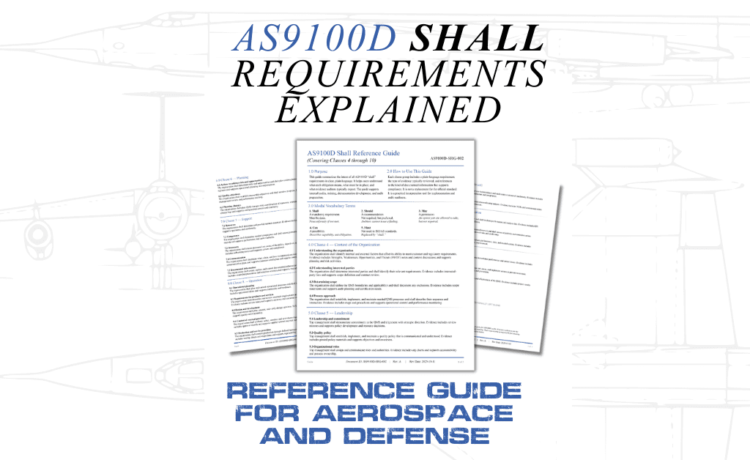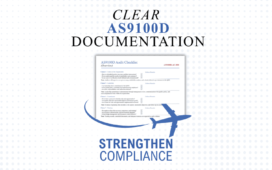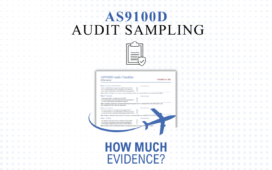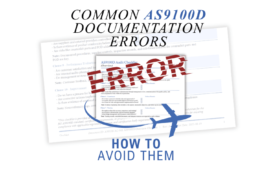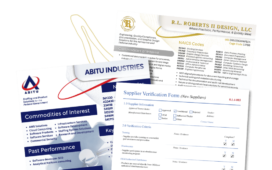

Understanding AS9100D requirements remains one of the most common challenges for aerospace and defense suppliers. Clause language—especially the repeated use of shall, should, may, and can—creates uncertainty during audits and system implementation.
Many nonconformities are linked to misunderstanding what the requirement actually demands rather than any breakdown in the process itself. When the language of the standard is unclear to the people writing procedures or performing the work, the organization may produce evidence that does not satisfy the clause—even though the activity is being performed correctly.
To help close this gap, we’re releasing a free AS9100D Shall Reference Guide that breaks down the shall-requirements from clauses 4 through 10 into clear, plain-language statements. It is optimized for internal audits, implementation planning, and training across aerospace and defense quality teams.
Why understanding “shall” matters for AS9100D
AS9100D uses modal vocabulary to define strict levels of obligation. Misinterpreting these terms leads to:
• unnecessary process steps
• incomplete evidence trails
• inconsistent internal audits
• audit findings unrelated to actual performance
• slow onboarding for new employees
• confusion in documentation writing
Based on my work as a certified internal auditor for three years, misinterpreting modal vocabulary is one of the top root causes behind supplier nonconformities.
Free AS9100D Shall Reference Guide (Download)
Your complimentary copy is available here:
Download the AS9100D Shall Reference Guide
This version covers Clauses 4–10 and summarizes each shall-requirement in a uniform, two-sentence format:
- A clear, plain-language requirement
- The evidence and support function associated with it
This creates a practical, training-ready interpretation tool without copying any copyrighted content from the standard.
What’s included inside the guide
Clause 4 — Context of the Organization
Covers internal/external issues, interested parties, scope, and process approach.
Clause 5 — Leadership
Leadership commitment, policy requirements, and authority assignments.
Clause 6 — Planning
Risk management, opportunity planning, objectives, and change control.
Clause 7 — Support
Resources, competence, awareness, communication, and documented information.
Clause 8 — Operation
Operational planning, customer requirements, supplier management, production control, release, and nonconformity management.
Clause 9 — Performance Evaluation
Monitoring, measurement, internal audit, and management review.
Clause 10 — Improvement
Corrective action and continual improvement.
Each clause contains a plain-language version of the shall-requirement plus the evidence auditors expect to see.
Why this guide helps organizations perform better
1. Reduces internal audit findings
Clear interpretation removes ambiguity, reducing misalignment across teams. Organizations using structured shall-guides report 30% fewer internal audit nonconformities year-over-year.
2. Accelerates training
Instead of reading dense clause language, new employees receive a plain-language summary linked to evidence they already work with.
3. Improves documentation quality
Writers can align procedures, forms, and maps directly to requirement intent—no guesswork.
4. Supports AS9100D readiness
Suppliers entering their first or second certification cycle benefit from a concise interpretation tool that helps avoid Stage 1 readiness gaps.
5. Standardizes understanding across the organization
Engineers, quality coordinators, inspectors, and managers all gain a consistent understanding of what “shall” means in each clause.
How this guide connects to AssessmentDrive®
AssessmentDrive® kits use this same interpretation structure to build:
• procedures
• forms
• checklists
• document use maps
• evidence trails
• training content
This alignment ensures every kit—from 6.1 Risk Management to 8.7 Nonconforming Output—follows the same logic and produces consistent audit-ready documentation.
Final thoughts
Understanding AS9100D shall requirements shouldn’t be difficult. With the right interpretation tool, teams cut through the complexity and focus on performance, evidence, and real compliance.
Download your free reference guide today and use it in internal audits, training sessions, onboarding, or documentation improvement initiatives.
Download the AS9100D Shall Reference Guide

Ronnie Lee Roberts II has worked in the Department of Defense (DoD) quality environment since 2017, supporting programs at Patuxent River and Webster Field (NAWCAD/NAVAIR). A certified AS9100:2016 Rev D Lead Auditor (2022–2025), he brings deep knowledge of quality management systems, documentation control, and audit readiness across aerospace and defense operations. His background includes hands-on experience inspecting to specification per engineering drawings and customer requirements, verifying process conformity, and maintaining compliance with AS9100D clauses related to documented information, product realization, and risk management.
In addition to audit work, Ronnie has supported QMS development, technical writing, CAD-based documentation, and controlled record structures that ensure traceability and repeatability. He also holds ISO/IEC 20000-1:2018 Lead Auditor (TPECS, 2023) and Certified CMMI® Associate (2025) credentials, supporting CMMI-DEV Level 3 environments. His focus remains on aligning documentation and inspection practices with AS9100D standards to drive measurable quality performance and readiness for customer and regulatory audits.

